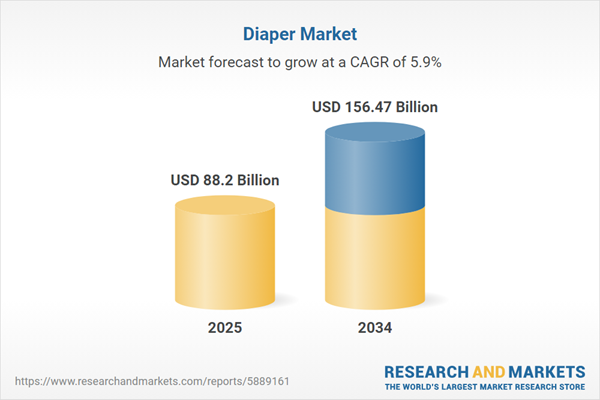A diaper refers to an underwear type, which requires the wearer not to use a toilet to urinate or defecate. It consists of synthetic materials or cloth. Cloth diapers comprise of multiple layers and are washable as well as recyclable, like hemp, cotton, and bamboo. On the other side, disposable slides would be discarded and composed of absorbent chemicals after use.
The inner lining of these paint strips is made of polypropylene, which prevents waste from being soiled by absorption or trapping of the exterior paint. The advances made in production technology have in recent years improved the design, biodegradability, and safety of cables, which has resulted in an enormous worldwide momentum.
In ancient times, methods of diapering varied greatly across different cultures. Materials like grass, moss, and linens were used as absorbent layers. With the industrial revolution and mass production of textiles, cloth diapers became more common. These were simply a square or rectangle of linen or cotton folded and placed around the baby's bottom. The first disposable diapers were developed by Marion Donovan after World War II. She used a shower curtain as the waterproof outer layer and combined it with absorbent inner layers.
The diaper market is continuously growing, with significant demand driven by the needs of infants and an ageing population in various countries. Some of the common innovations include improved absorbency materials, better-fit designs, and environmentally friendly manufacturing processes.
Global Diaper Market Segmentation
The report titled “Diaper Market Report and Forecast 2025-2034” offers a detailed analysis of the market based on the following segments:Based on product type, the baby diaper market can be segmented into the following:
- Disposable
- Training
- Cloth
- Swim
- Biodegradable
Their high absorbency rate reduces the risk of leaks and generally keeps the baby's skin drier for longer periods. There is a growing market for eco-friendly disposables, made with biodegradable materials and less harmful chemicals. Ongoing innovations focus on making diapers thinner, more absorbent, and more comfortable for babies.
On the basis of product type, the adult diaper market can be divided into:
- Pad Type
- Flat Type
- Pant Type
Pad-type adult diapers are often preferred by people leading active lifestyles due to their discreet nature, further contributing to the diaper market growth. They can be used with regular underwear, making them a flexible option for incontinence management.
Based on the distribution channel, the market can be divided into:
- Supermarkets and Hypermarkets
- Pharmacies
- Convenience Stores
- Online Stores
- Others
Due to their large scale, supermarkets often offer competitive prices, including discounts and promotions, which can be a key factor for consumers when purchasing diapers. Additionally, new diaper products are often launched in supermarkets and hypermarkets, benefiting from high foot traffic and visibility.
On the basis of region, the adult diaper market can be divided into:
- North America
- Europe
- Asia-Pacific
- Latin America
- Middle East and Africa
Global Market Share by Region
North America accounts for a significant portion of the global diaper market share, accounting for the majority of the market share. The market is significantly being supported by the rising demand in the Asia-Pacific region, especially India. The advent of biodegradable diapers impacts the market further since they are environmentally friendly in nature as well as reduce environmental pollution.In addition, increasing online sales, combined with rapid urbanisation, will also foster the market in the Asia-Pacific region. In India, the market for diapers continues to grow due to its advantages including comfort, hygiene, and a reduced risk of harm to the skin. In addition, an increase in the awareness of personal hygiene, changes in lifestyles, and a dramatic increase in consumers' purchasing power in India have led to consumers moving from conventional clothes to diapers.
Global Diaper Market Analysis
The occurrence of urinary incontinence has risen globally among the increasing population of adults and elderly, which has supported the global diaper market demand. In addition, high birth rates in developing nations, delaying children's toilet training, and the rising developments in baby products shopping online have helped to boost growth in the market.Furthermore, the demand for biodegradable diapers made from environmentally friendly materials has increased significantly. This trend has led to diaper manufacturers producing goods using raw materials that degrade much faster than conventional clothing. In addition, the continued activities for research and development that are aimed at improving the quality of goods and the introduction of new technology into the production of diapers will further drive the market expansion. For example, the development of absorbing core technology to eliminate the fluff pulp has allowed thinner diapers to be manufactured.
Competitive Landscape
The report gives a detailed analysis of the following key players in the global diaper market, covering their competitive landscape, capacity, and latest developments like mergers, acquisitions, and investments, expansions of capacity, and plant turnarounds:- Kao Corporation
- Kimberly-Clark Corporation
- Procter & Gamble Company
- Unicharm Corporation
- Others
Table of Contents
Companies Mentioned
The key companies featured in this Diaper market report include:- Kao Corporation
- Kimberly-Clark Corporation
- Procter & Gamble Company
- Unicharm Corporation
Table Information
| Report Attribute | Details |
|---|---|
| No. of Pages | 172 |
| Published | August 2025 |
| Forecast Period | 2025 - 2034 |
| Estimated Market Value ( USD | $ 88.2 Billion |
| Forecasted Market Value ( USD | $ 156.47 Billion |
| Compound Annual Growth Rate | 5.9% |
| Regions Covered | Global |
| No. of Companies Mentioned | 5 |









